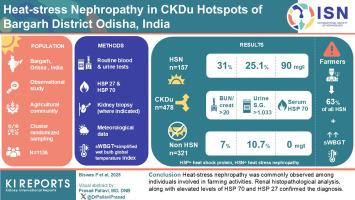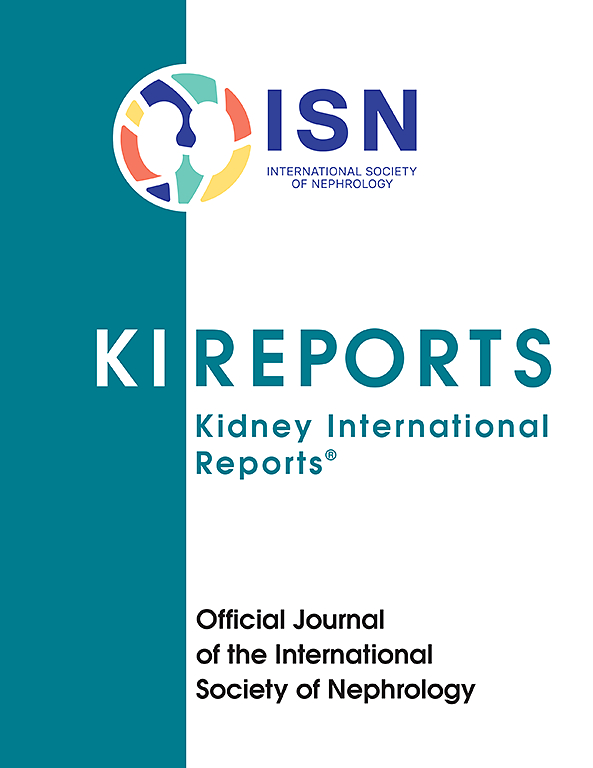Heat Stress Nephropathy in CKD of Uncertain Etiology Hotspots of Bargarh District Odisha, India
IF 5.7
2区 医学
Q1 UROLOGY & NEPHROLOGY
引用次数: 0
Abstract
Introduction
Repeated heat exposure, physical exertion, and inadequate hydration can cause acute kidney injury (AKI), potentially progressing to chronic kidney disease (CKD). However, cohort-level research on heat stress as a contributing factor remains limited. This study investigates occupational heat exposure among farming communities in hotspot villages of Bargarh district, Odisha, India.
Methods
A cross-sectional study of 1136 participants was conducted in Bargarh district to assess heat stress nephropathy among agricultural workers. Based on Sri Lankan criteria, heat stress nephropathy was defined by albumin-creatinine ratio ≥ 30 mg/g, no known CKD causes, urine specific gravity ≥ 1.03, and signs of tubulointerstitial nephritis. Heat stress index, serological tests, and urine analyses were performed using standard protocols. Serum and urine levels of heat shock protein (HSP)27 and HSP70 were measured via enzyme-linked immunosorbent assay. Renal biopsies were conducted on 8 selected patients for histopathological evaluation.
Results
Out of the total screened population, 157 potential cases of heat stress nephropathy were identified, with 63.3% of affected individuals being farmers. The Attabira block recorded the highest heat stress index and the most CKD of uncertain etiology (CKDu) cases among farmers. Markers of dehydration, including the simplified wet bulb globe temperature (sWBGT) index, urine specific gravity (64.09%), albumin-to-creatinine ratio (5.88%), blood urea nitrogen (BUN, 63.2%), and HSP, were significantly elevated in the farming population compared with the control group. Renal histopathological analysis revealed tubulointerstitial nephritis with signs of fibrosis.
Conclusion
Heat stress nephropathy was commonly observed among individuals involved in farming activities. Renal histopathological analysis, along with elevated levels of HSP70 and HSP27 confirmed the diagnosis.

印度奥里萨邦Bargarh地区不明病因CKD热应激肾病热点
反复的热暴露、体力消耗和水分不足可导致急性肾损伤(AKI),并有可能发展为慢性肾脏疾病(CKD)。然而,对热应激作为一个影响因素的队列水平的研究仍然有限。本研究调查了印度奥里萨邦巴加尔地区热点村庄农业社区的职业热暴露情况。方法在Bargarh地区对1136名参与者进行了横断面研究,以评估农业工人的热应激性肾病。根据斯里兰卡标准,热应激肾病的定义为白蛋白-肌酐比值≥30 mg/g,无已知CKD原因,尿比重≥1.03,有肾小管间质性肾炎的迹象。采用标准方案进行热应激指数、血清学测试和尿液分析。采用酶联免疫吸附法测定血清和尿液热休克蛋白(HSP)27和HSP70水平。选择8例患者行肾活检进行组织病理学评价。结果在筛查人群中,发现157例热应激肾病潜在病例,其中农民占63.3%。在阿塔比拉地区,农民的热应激指数最高,病因不明的慢性肾病(CKDu)病例最多。脱水指标包括简化湿球温度(sWBGT)指数、尿比重(64.09%)、白蛋白与肌酐比(5.88%)、血尿素氮(BUN, 63.2%)和热sp均显著高于对照组。肾组织病理学分析显示肾小管间质性肾炎伴纤维化征象。结论热应激性肾病在从事农业活动的人群中较为常见。肾脏组织病理学分析,以及HSP70和HSP27水平升高证实了诊断。
本文章由计算机程序翻译,如有差异,请以英文原文为准。
求助全文
约1分钟内获得全文
求助全文
来源期刊

Kidney International Reports
Medicine-Nephrology
CiteScore
7.70
自引率
3.30%
发文量
1578
审稿时长
8 weeks
期刊介绍:
Kidney International Reports, an official journal of the International Society of Nephrology, is a peer-reviewed, open access journal devoted to the publication of leading research and developments related to kidney disease. With the primary aim of contributing to improved care of patients with kidney disease, the journal will publish original clinical and select translational articles and educational content related to the pathogenesis, evaluation and management of acute and chronic kidney disease, end stage renal disease (including transplantation), acid-base, fluid and electrolyte disturbances and hypertension. Of particular interest are submissions related to clinical trials, epidemiology, systematic reviews (including meta-analyses) and outcomes research. The journal will also provide a platform for wider dissemination of national and regional guidelines as well as consensus meeting reports.
 求助内容:
求助内容: 应助结果提醒方式:
应助结果提醒方式:


